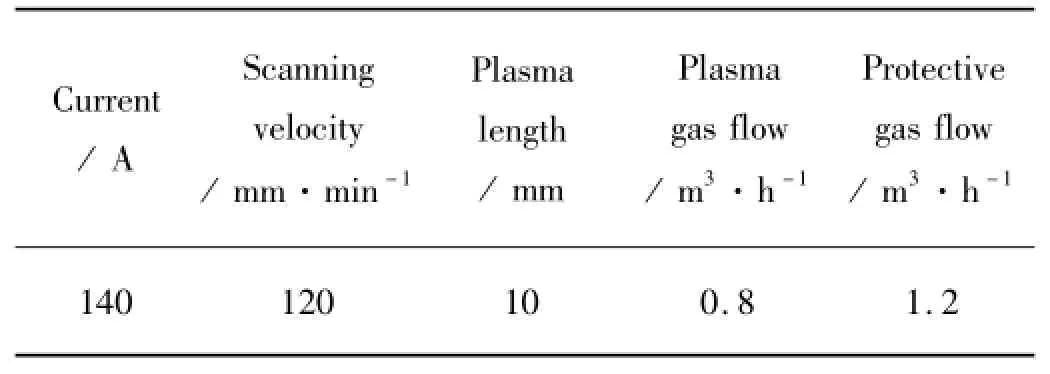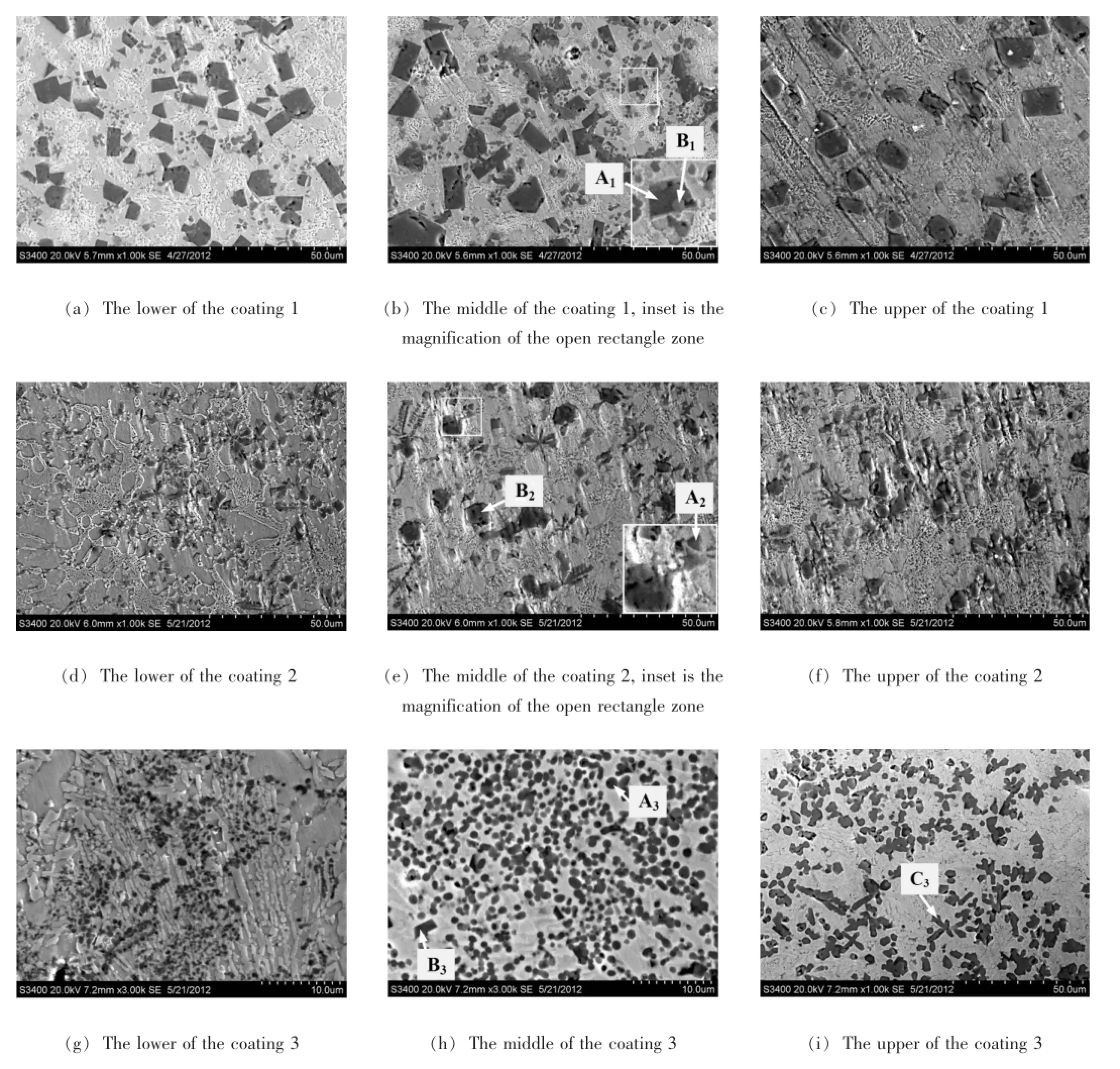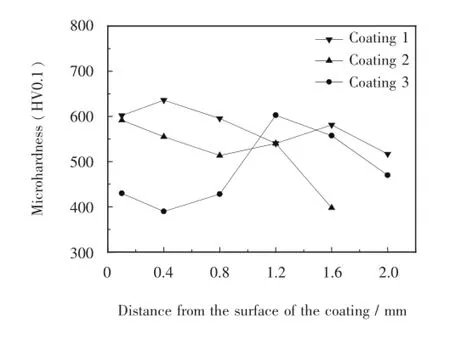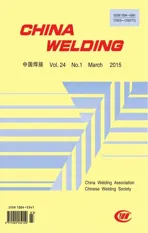Effects of C/B4C ratio on Microstructure and property of Fe-based alloy coatings reinforced w ith in situ synthesized TiB2-TiC*
2015-09-05JiangShaoqunWangGangChangyueWangZehuaandZhouZehua江少群吕长月王泽华周泽华
Jiang Shaoqun,Wang Gang,LüChangyue,Wang Zehua and Zhou Zehua江少群,王 刚,吕长月,王泽华,周泽华**
Effects of C/B4C ratio on Microstructure and property of Fe-based alloy coatings reinforced w ith in situ synthesized TiB2-TiC*
Jiang Shaoqun,Wang Gang,LüChangyue,Wang Zehua and Zhou Zehua
江少群,王 刚,吕长月,王泽华,周泽华**
The Fe-based alloy coatings reinforced with in situ synthesized TiB2-TiC were prepared on Q235 steel by reactive plasma cladding using Fe901 alloy,Ti,B4C,and graphite(C)powders as raw materials.The effects of C/B4C weight percentage ratio(0-1.38)on themicrostructure,microhardness,and wet sand abrasion resistance of the coatings were investigated.The resultsshow that the coatings consist of(Fe,Cr)solid solution,TiC,TiB2,Ti8C5,and Fe3C phases.The decrease of C/B4C ratio ispropitious to the formation of TiB2and Ti8C5.Increasing the C/B4C ratio can help to refine the microstructure of the coatings.However,theMicrohardness of the middle-upper of the coatings and the wet sand abrasion resistance of the coatings degenerate with the increase of C/B4C ratio.The coating exhibits the best wet sand abrasion resistance at C/B4C=0 and itsaveragemass loss rate per unitwear distance is 0.001 2%/m.The change of the wet sand abrasion resistance of the coatingswith the C/B4C ratio can bemainly attributed to the combined action of the changes of microhardness and the volume percentage of the ceramic reinforcements containing titanium in the coatings.
plasma cladding,Fe-based alloy coating,TiB2-TiC,in situ synthesis,abrasion
0 Introduction
Wear is one of themain failuremodes ofmaterials.It usually stems from the surface of materials.Therefore,strengthening the surfaces of thematerials by some surface treatment techniques has often been done to improve the wear resistance of the materials[1-2].Reactive plasma cladding is an effective surface strengthening technique.It can improve the wear resistance of the materials obviously by cladding the coatings with good wear resistance on the surfaces of the materials[3-4].Due to its high efficiency,low cost,ease of operation,and,especially,its applicability to a wide range ofmaterials,reactive plasma cladding is a highly promising process for the fabrication and reparation of engineering anti-wear components.At present,the anti-wear coatings prepared by reactive plasma cladding include mainly Ni-,Co-,and Fe-based coatings[5-7].Fe-based coating has become a research focus in recent years due to its high hardness and excellentwear resistance,especially its low cost compared to the other metalmatrix coatings.In order to further improve the wear resistance,the in situ synthesized ceramic phases are usually embedded in the clad coatings as reinforcements.A-mong various ceramic particulates,TiC and TiB2become preferred reinforcements on account of their high hardness,high melting temperature,low density,high chemical stability and outstanding tribological properties[8-11]. Up to now,there are lots of researches on Fe-based clad coatings reinforced with TiC or TiB[12-13].Unfortunately,2there are few reports on Fe-based alloy plasma clad coatings reinforced with in situ synthesized TiB2-TiC,espe-cially the effect of TiB2/TiC ratio on the clad coatings.
The researches indicated that TiC-TiB2composite ceramic materials had comprehensive properties superior to those of TiB2or TiC single phase ceramic material.Moreover,the hardness,wear resistance,fracture toughness of the TiC-TiB2composite ceramic were directly relevant to the TiC/TiB2ratio[14-15].
Therefore,in this work,the Fe-based alloy coatings reinforced with in situ synthesized TiB2-TiC have been deposited on Q235 steel by reactive plasma cladding using Fe901 alloy,B4C,Ti,and graphite powders as raw materials.The TiB2/TiC ratio of the clad coatings is adjusted by changing the C/B4C weight percentage ratio of the reactants.The effects of C/B4C weight percentage ratio on the microstructure,microhardness,and wet sand abrasion resistance of the clad coatings have been investigated in detail.
1 Experiments
Commercial Q235 steel was chosen as substrate.The dimensions of the substrateswere50mm×26mm×6mm. Prior to the cladding process,the substrates were blasted with sands and cleaned with acetone in an ultrasonic cleaner for 15 min to remove grease and residue.The raw claddingmaterials included Fe901 alloy powder(particle size:44-104μm),Tipowder(particle size:~50μm,purity:99.5%),B4C powder(particle size:28-40μm,purity:≥99.0%),and graphite powder(particle size:~50μm,purity:99.9%).The chemical composition of Fe901 alloy powderwas13 wt.%Cr,1.2 wt.%Si,1.6 wt.%B,0.8 wt.%Mo,and Fe in balance.Table 1 shows the proportion of the constituents of the precursor powder mixture by weight for different Fe-based alloy coatings.According to the composition design,the TiB2/TiC weight percentage ratio of the coating1,2 and 3 was about 70∶30,(47-48)∶(52-53)and 24∶76 respectively,which was calculated as per the chemical reactions shown in Eq.(1)and Eq.(2)and was an ideal value.

To obtain a homogenous distribution,all measured quantities of raw powders for each coating were mixed by alternate cycles ofmanual stirring.Then a smallamountof self-made adhesivewas added into themixture.Aftermixing uniformly,the blend was preplaced manually on Q235 steel surface.The thickness of the preplaced layers was about 2 mm.In order to enhance the adhesion effect between the preplaced layer and substrate and removemoisture,the samples were dried thoroughly in a furnace at 100℃for 2 h before cladding process.The cladding experiments were carried out using the optimized parameters listed in Table 2 on the LHD-300 plasma cladding equipment.Arwas chosen as plasma gas and protective gas.In order tomeet the demand for adequate width,all the clad coatings for wear tests were prepared by double-pass plasma cladding process.The overlap ratio of the two passes was about30%.
The phase structure characterization was performed by X-ray diffraction(XRD)with Cu Kαradiation.The microstructure analyses were done by scanning electron microscope(SEM).Energy dispersive spectroscopy(EDS)was used to analyze the compositions of the coatings.Microhardness testswere performed on coating cross-sections using an HXD-1000TC microhardness tester with a 100 g load and a dwell time of 15 s.Wear tests were performed on MLS-225 wet sand rubberwheel apparatus at a constant rubber wheel rotational speed of182 r/min and load of70 N under themixedmedium composed of1 000 gwater and 1 500 g quartz sand for 5 min.The particle size of the quartz sandswas about200-420μm.The diameter of the rubber wheelwas 178 mm.

Table 1 Com position of the reactants of the coatings

Table 2 Reactive plasma cladding process parameters
2 Results and discussion

Fig.1 X-ray diffraction patterns of the Fe-based alloy coatings
The SEM micrographs of the cross-sections of the coatings are shown in Fig.2.Table 3 gives the chemical compositions of the corresponding micro-regions in the coatings.It can be found that the microstructure of the coatings strongly depends on C/B4C ratio and it exhibits an obvious gradient distribution along the depth direction. When C/B4C ratio is 0,as shown in Fig.2a-Fig.2c,plenty of relatively coarse black strip/block precipitations and some fine dark grey spherical/block precipitations are distributed in the Fe-based alloymatrix.The EDS results indicate that the black block phase A1is rich in Ti and B and contains a certain amount of Cr and Fe,however,the dark grey spherical phase B1is rich in Ti and C(Ti/C atomic ratio isabout1.9)and only contains a small amount of Fe and Cr.A part of the Fe and Cr signalsmay come from the Fe-Cr matrix owing to the small size of the analyzed phases or the presence of small thin regions on the phases.According to the results of XRD,it can be concluded that the black strip/block phases are TiB2and the fine dark grey spherical/block phases are titanium carbides(TiC and Ti8C5).TiB2strip/block morphology relates to its C32 crystal structure[11].At C/B4C=0.33,the morphology of the precipitations in the coating 2 (shown in Fig.2d-Fig.2f)can be approximately categorized into two kinds:black block and dark grey flowerlike/fine block.The EDS results of the precipitations (marked with A2and B2)indicate that dark grey phase A2ismainly composed of Ti,Fe,C and a small amountof Cr and Si,however,the black block phase B2is rich in Ti and B and contains a little of Fe and Cr.Based on the above analysis,it can be deduced that TiC presents in flower-like/fine block form and TiB2precipitates in block form at this C/B4C ratio.When C/B4C ratio increases to1.38,as shown in Fig.2g-Fig.2i,the precipitations in the coating 3 are smaller than those of the former two and theygradually become coarse from the bottom to the upper of the coating.At the lower and themiddle of the coating 3,the precipitationsmainly present in spherical form and only a few precipitations are fine strip shape.The precipitations present in fine block or flower-like form at the upper of the coatings.EDS analysis was used to ascertain the chemical composition of these precipitations with different morphologies.It can be found that the spherical phase A3is rich in Ti,Fe,C and only contains a small amount of Cr and Si.The flower-like phase C3is rich in Ti and C (Ti/C atomic ratio is about 1)and contains a trace of Cr and Fe.According to the XRD results,it can be concluded that the spherical precipitationsmainly consist of titanium carbides(TiC,Ti8C5)and a small amount of Fe3C and the flower-like precipitations mainly consist of TiC. Clearly,themorphology of TiC is variable along the depth direction of the coating.Ali Emamian et al.[2]pointed out that the morphology of TiC depended on the state of the molten pool during the cladding process.When themolten pool was partially solid,the TiC preferred to precipitate in spherical form.The TiC usually precipitated in flower-like form or dendrite structure if themolten poolwas fully liquid.In fact,the state of themolten pool has a vital effect on the formation mechanism of TiC.Therefore,it is reasonable to deduce that themorphology of the in situ formed TiC by reactive plasma cladding depends on its formation mechanisms.The EDS result of the fine strip phase B3indicates that it contains Ti(18.31at.%),B(50.63at.%),C(25.62at.%)and a small amount of Fe and Cr.This verifies that the titanium carbides and boride at themiddle portion of the coatings 3 are formed by solid state diffusion mechanism.By comparing the EDS results of carbide phases B1,A2and A3,it can be found that the contents of Fe and C increase and the content of Ti decreases in turn. This implies that the increase of C/B4C ratio can promote the formation of Fe3C and depress the formation of Ti8C5. Based on the microstructure of the coatings and the above analysis,it can be concluded that increasing the C/B4C ratio can promote the formation of Fe3C and decreasing the C/B4C ratio is in favor of the formations of TiB2and Ti8C5.
Obviously,the C/B4C ratio has an important effect on themorphology of the precipitations and the contents of TiC,Ti8C5,Fe3C and TiB2.The increase of the C/B4C ratio is beneficial to the refinementof themicrostructure of the coatings.There are plenty of TiB2in the coating at C/ B4C=0 and a lot of titanium carbides precipitate in the coating at C/B4C=1.38.

Table 3 EDS results of the coatings
Fig.3 gives the microhardness of the coatings as a function of coating depth.The microhardness of the coatings exhibits a nonmonotonic change along the depth direction.Thismainly results from the gradient distribution and distribution nonuniformity in microscale of the microstructure of the coatings.With the increase of C/B4C ratio,the microhardness of themiddle-upper of the coatings decreases gradually.The microhardness of the part which is in the depth range of 0-0.8 mm from the surface of the coating is about 595.5-635.9 HV0.1 at C/B4C=0,however,it is about 389.9-429.8 HV0.1 at C/B4C= 1.38.It indicates that the microhardness of the middleupper of the coatings can be improved by suitably increasing the TiB2/TiC ratio.
In order to further understand the effect of C/B4C ratio on the properties of the coatings,wet sand abrasion tests have been carried out.Due to the composition difference of the precursor,themasses of the coatings with thesame size are different from each other.Therefore,the relative wear rateε(averagemass loss rate(%)per unit wear distance(m))calculated as per Eq.(3)is used to estimate the wet sand abrasion resistance of the coatings. m1is themass of sample before thewetsand abrasion test,m2themass of sample after the wet sand abrasion test,msthemass of substrate,D the diameter of the rubberwheel,t wear time(min)and v the rotational speed of the rubber wheel(r/min).Table 4 shows theεof the coatings.It can be found that the coatings exhibit good wet sand abrasion resistance and the decrease of C/B4C ratio can result in the improvement of the wet sand abrasion resistance of the coatings.Theεof the coating at C/B4C=0 is about 50%of that of the coating at C/B4C=1.38.


Fig.2 SEM Micrographs of cross-sections of the coatings

Fig.3 Microhardness profile of the Fe-based alloy coatings

Table 4 Relative wear rate of the coatings
Fig.4 shows the morphologies of the worn surface of the coatings.There are a few shallow worn scars on the surface of the coating at C/B4C=0.With the increase of C/B4C ratio,more worn scars occur on the surface of the coatings and the depth of worn scars also increases.It is mainly because:(1)Themicrohardnessof themiddle-upper of the coatings decreases with the increase of C/B4C ratio;(2)The increase of C/B4C ratio results in the decrease of TiB2/(TiB2+TiC)weight percentage ratio of the coatings.Thismeans that the volume percentage of TiB2+ TiC reinforcement decreases with the increase of C/B4C ratio,since the density of TiB2is lower than that of TiC. Then the probability and the area that the wet sands contactwith non-ceramic phases also increase when the wet sands scratch the surface of the coating,which does cause the degeneration of the wet sand abrasion resistance.This implies that the wet sand abrasion resistance of the coatings can be improved by suitably increasing the TiB2/TiC weight percentage ratio.

Fig.4 Worn surfacemorphologies of the coatings
3 Conclusions
(1)The C/B4C weight percentage ratio plays an important role in themicrostructure and properties of the Febased alloy coatings reinforced with in situ synthesized TiB2-TiC.
当猪场已经发生猪流行性腹泻病时候,应该对猪场进行全面消毒工作,对厂区周围也要进行播撒生石灰消毒,从而切断传染源。做好猪舍的保温工作是重要环节,一般采用保温灯的效果比较好。预防机体脱水、酸中毒,抗菌消炎同时也要止泻补液。
(2)The change of C/B4C ratio(0-1.38)has not resulted in the formation of any new phase.But the increase of C/B4C ratio can promote the formation of Fe3C and is propitious to refining themicrostructure of the coatings.Decreasing the C/B4C ratio can promote the formation of TiB2and Ti8C5and improve the wet sand abrasion resistance of the coatings.
(3)The microhardness of the middle-upper of the coatings decreases with the increase of the C/B4C ratio.
(4)The wet sand abrasion resistance of the coatings can be improved by suitably increasing the TiB2/TiC weight percentage ratio.
References
[1] Jiang SQ,Ren QW,Ding Y,et al.Characteristics of Febased WC composite coatings prepared by double-pass plasma cladding process.Rare Metal Materials and Engineering,2012,41(S1):195-198.
[2] Emam ian A,Corbin S F,Khajepour A.The influence of combined laser parameters on in-situ formed TiCmorphology. Surface&Coatings Technology,2011,206:124-131.
[3] Liu JB,Wang L M,Li H Q.Reactive plasma cladding of TiC/Fe cermet coating using asphalt as a carbonaceous precursor.Applied Surface Science,2009,255:4921-4925.
[4] Liu JB,Wang LM,Huang JH.Wear properties of reactive plasma clad(Cr,Fe)7C3/γ-Fe ceramal composite coatings. Journal of University of Science and Technology Beijing,2007,29(1):50-54.(in Chinese)
[5] Wu Y P,Peng Z Q,Lin P H.In-situ synthesis of TiC particle reinforced nickel base alloy composite coating by plasma cladding.Materials Science&Technology,2004,12(4):429-432.(in Chinese)
[6] Zhang L M,Sun D B,Yu H Y.Effect of niobium on themicrostructure and resistance of iron-based alloy coating produced by plasma cladding.Materials Science and Engineering A,2008,490:57-61.
[7] D'Oliveira A SC M,Paredes R SC,Santos R L C.Pulsed current plasma transferred arc hardfacing.Journal of Materials Processing Technology,2006,171:167-174.
[8] Hamedi M J,Torkamany M J,Sabbaghzadeh J.Effect of pulsed laser parameters on in-situ TiC synthesis in laser surface treatment.Optics and Lasers in Engineering,2011,49:557-563.
[9] Du B S,Zou ZD,Wang X H,etal.Laser cladding of in situ TiB2/Fe composite coating on steel.Applied Surface Science,2008,254:6489-6494.
[10] Yang S,Chen N,Liu W J,et al.Fabrication of nickel composite reinforced with TiC particles by laser cladding. Surface and Coatings Technology,2004,183:254-260.
[11] Wang X H,Pan X N,Du B S,et al.Production of in situ TiB2+TiC/Fe composite coating from precursor containing B4C-TiO2-Al powders by laser cladding.Transactions of Nonferrous Metals Society of China,2013,23:1689-1693.
[12] Liu JB,Jiang JS,Tan ZQ,et al.Influence of C/Tiatomic ratio on TiC/Fe composites coating using sucrose as a carbonaceous precursor by plasma cladding.Heat Treatment of Metals,2008,33(6):50-53.(in Chinese)
[13] Anal A,Bandyopadhyay T K,Das K.Synthesisand characterization of TiB2-reinforced iron-based composites.Journal of Materials Processing Technology,2006,172:70-76.
[14] Zhang X H,Zhu C C,Qu W,et al.Self-propagating high temperature combustion synthesis of TiC/TiB2ceramic-matrix composites.Composites Science and Technology,2002,62:2037-2041.
[15] Lu D Q,Wang J J,Du X K,et al.Effects of content of titanium on self-propagating high temperature synthesis of Ti-B4C-C system.Journal of Ordnance Engineering College,2004,16(6):4-7.(in Chinese)
*Thiswork is supported by the National Natural Science Foundation of China(Grant No.51101051),the Natural Science Foundation of Jiangsu Province(Grant No.BK2011250),and Jiangsu Planned Projects for Postdoctoral Research Funds(Grant No.1101017C).
**Jiang Shaoqun,Wang Gang,Wang Zehua and Zhou Zehua,College of Mechanics and Materials,Hohai University,Nanjing,210098. Jiang Shaoqun,Changzhou Hohai Institute of Science and Technology Limited Liability Company,Changzhou,213164. LüChangyue,School of Materials Science and Engineering,Southeast University,Nanjing,211189. Jiang Shaoqun,Corresponding author,E-mail:sqjhit@126. com.
猜你喜欢
杂志排行
China Welding的其它文章
- A Fe-Ni-Cr system filler metal for brazing of stainless steel*
- Numerical analysis of thermal process in continuous drive radial friction welding*
- Effect of refilling time on Microstructure and Mechanical properties of friction spot welded LY12 alum inum alloy*
- Simulation of phased array S-scan acoustic field in FSW joint of alum inum alloy extrudate w ith com p lex shape*
- Mechanical and corrosion properties of 445J2 ultra pure ferritic stainless steel joint*
- Simulation on the deformation controlling of T-joint LBW w ith auxiliary heat source for high strength alum inum alloy*
